- Home
- Arthur C. Clarke
The Songs of Distant Earth Page 9
The Songs of Distant Earth Read online
Page 9
These clumsy trees and crude ferns could have been the raw material of the coal beds that had powered the Industrial Revolution – barely in time to save the human race. He could easily believe that a dinosaur might come charging out of the undergrowth at any moment; then he recalled that the terrible lizards had still been a hundred million years in the future when such plants had flourished on Earth …
They were just remounting when Loren exclaimed, “Krakan and damnation!”
“What’s the matter?”
Loren collapsed on what, providentially, appeared to be a thick layer of wiry moss.
“Cramp,” he muttered through clenched teeth, grabbing at his knotted calf muscles.
“Let me,” Mirissa said in a concerned but confident voice.
Under her pleasant, though somewhat amateur, ministrations, the spasms slowly ebbed.
“Thanks,” Loren said after a while. “That’s much better. But please don’t stop.”
“Did you really think I would?” she whispered.
And presently, between two worlds, they became one.
IV – Krakan
21. Academy
The membership of the Thalassan Academy of Science was strictly limited to the nice round binary number 100000000 – or, for those who preferred to count on their fingers, 256. Magellan’s Science Officer approved of such exclusivity; it maintained standards. And the academy took its responsibilities very seriously; the president had confessed to her that at the moment there were only 241 members, as it had proved impossible to fill all the vacancies with qualified personnel.
Of those 241, no less than 105 were physically present in the academy’s auditorium, and 116 had logged in on their comsets. It was a record turnout, and Dr. Anne Varley felt extremely flattered – though she could not suppress a fleeting curiosity about the missing 20.
She also felt a mild discomfort at being introduced as one of Earth’s leading astronomers – even though, alas, by the date of Magellan’s departure, that had been all too true. Time and Chance had given the late director of the – late – Shklovskii Lunar Observatory this unique opportunity of survival. She knew perfectly well that she was no more than competent when judged by the standards of such giants as Ackerley or Chandrasekhar or Herschel – still less by those of Galileo or Copernicus or Ptolemy.
“Here it is,” she began. “I’m sure you’ve all seen this map of Sagan – the best reconstruction possible from fly-bys and radioholograms. The detail’s very poor, of course – ten kilometres at the best – but it’s enough to give us the basic facts.”
“Diameter – fifteen thousand kilometres, a little larger than Earth.A dense atmosphere – almost entirely nitrogen. And no oxygen – fortunately.”
That “fortunately” was always an attention-getter; it made the audience sit up with a jolt.
“I understand your surprise; most human beings have a prejudice in favour of breathing. But in the decades before the Exodus, many things happened to change our outlook on the Universe.
“The absence of other living creatures – past or present – in the solar system and the failure of the SETI programs despite sixteen centuries of effort convinced virtually everyone that life must be very rare elsewhere in the universe, and therefore very precious.
“Hence it followed that all life forms were worthy of respect and should be cherished. Some argued that even virulent pathogens and disease vectors should not be exterminated, but should be preserved under strict safeguards. “Reverence for life” became a very popular phrase during the Last Days and few applied it exclusively to human life.
“Once the principle of biological non-interference was accepted, certain practical consequences followed. It had long been agreed that we should not attempt any settlement on a planet with intelligent life-forms; the human race had a bad enough record on its home world. Fortunately – or unfortunately! – this situation has never arisen.
“But the argument was taken further. Suppose we found a planet on which animal life had just begun. Should we stand aside and let evolution take its course on the chance that megayears hence intelligence might arise?
“Going still further back – suppose there was only plant life? Only single-cell microbes?
“You may find it surprising that, when the very existence of the human race was at stake, men bothered to debate such abstract moral and philosophical questions. But Death focuses the mind on the things that really matter: why are we here, and what should we do?
“The concept of “Metalaw” – I’m sure you’ve all heard the term – became very popular. Was it possible to develop legal and moral codes applicable to all intelligent creatures, and not merely to the bipedal, air-breathing mammals who had briefly dominated Planet Earth?
“Dr Kaldor, incidentally, was one of the leaders of the debate. It made him quite unpopular with those who argued that since H. sapiens was the only intelligent species known, its survival took precedence over all other considerations. Someone coined the effective slogan: ‘If it’s Man or Slime Moulds, I vote for Man!’
“Fortunately, there’s never been a direct confrontation – as far as we know. It may be centuries before we get reports from all the seedships that went out. And if some remain silent – well, the slime moulds may have won…
“In 3505, during the final session of the World Parliament, certain guidelines – the famous Geneva Directive – were laid down for future planetary colonization. Many thought that they were too idealistic, and there was certainly no way in which they could ever be enforced. But they were an expression of intent – a final gesture of goodwill towards a Universe which might never be able to appreciate it.
“Only one of the directive’s guidelines concern us here – but it was the most celebrated and aroused intense controversy, since it ruled out some of the most promising targets.
“The presence of more than a few percent oxygen in a planet’s atmosphere is definite proof that life exists there. The element is far too reactive to occur in the free state unless it is continually replenished by plants – or their equivalent. Of course, oxygen doesn’t necessarily mean animal life, but it sets the stage for it. And even if animal life only rarely leads to intelligence, no other plausible route to it has ever been theorized.
“So, according to the principles of Metalaw, oxygen-bearing planets were placed out of bounds. Frankly, I doubt so drastic a decision would have been made if the quantum drive hadn’t given us essentially unlimited range – and power.
“Now let me tell you our plan of operation, when we have reached Sagan 2. As you will see by the map, more than fifty per cent of the surface is ice-covered, to an estimated average depth of three kilometres. All the oxygen we shall ever need!
“When it’s established its final orbit, Magellan will use the quantum drive, at a small fraction of full-power, to act as a torch. It will burn off the ice and simultaneously crack the steam into oxygen and hydrogen. The hydrogen will quickly leak away into space; we may help it with tuned lasers, if necessary.
“In only twenty years, Sagan 2 will have a ten per cent O2 atmosphere, though it will be too full of nitrogen oxides and other poisons to be breathable. About that time we’ll start dumping specially developed bacteria, and even plants, to accelerate the process. But the planet will still be far too cold; even allowing for the heat we’ve pumped into it, the temperature will be below freezing everywhere except for a few hours near noon at the Equator.
“So that’s where we use the quantum drive, probably for the last time. Magellan, which has spent its entire existence in space, will finally descend to the surface of a planet.
“And then, for about fifteen minutes every day at the appropriate time, the drive will be switched on at the maximum power the structure of the ship – and the bedrock on which it is resting – can withstand. We won’t know how long the operation will take until we have made the first tests; it may be necessary to move the ship again if the initial site is geologically unstabl
e.
“At a first approximation, it appears that we’ll need to operate the drive for thirty years, to slow the planet until it drops sunward far enough to give it a temperate climate. And we’ll have to run the drive for another twenty-five years to circularize the orbit. But for much of that time Sagan 2 will be quite livable – though the winters will be fierce until final orbit is achieved.
“So then we will have a virgin planet, larger than Earth, with about forty percent ocean and a mean temperature of twenty-five degrees. The atmosphere will have an oxygen content seventy percent of Earth’s – but still rising. It will be time to awaken the nine hundred thousand sleepers still in hibernation, and present them with a new world.
“That is the scenario unless unexpected developments – or discoveries – force us to depart from it. And if the worst comes to the worst …”
Dr. Varley hesitated, then smiled grimly.
“No – whatever happens, you won’t be seeing us again! If Sagan 2 is impossible, there is another target, thirty light-years farther on. It may be an even better one.
“Perhaps we will eventually colonize both. But that is for the future to decide.”
The discussion took a little time to get under way; most of the Academicians seemed stunned, though their applause was certainly genuine. The president, who through long experience always had a few questions prepared in advance, started the ball rolling.
“A trivial point, Dr. Varley – but who or what is Sagan 2 named after?”
“A writer of scientific romances, early Third Millennium.”
That broke the ice, just as the president had intended.
“You mentioned, Doctor, that Sagan 2 has at least one satellite. What will happen to it, when you change the planet’s orbit?”
“Nothing, apart from very slight perturbations. It will move along with its primary.”
“If the directive of – what was it, 3500 –”
“3505.”
“– had been ratified earlier, would we be here now? I mean, Thalassa would have been out of bounds!”
“It’s a very good question, and we’ve often debated it. The 2751 seeding mission – your Mother Ship on South Island – would certainly have gone against the directive. Luckily, the problem hasn’t arisen. Since you have no land animals here, the principle of non-interference hasn’t been violated.”
“This is very speculative,” one of the youngest of the Academicians said – to the obvious amusement of many of her elders. “Granted that oxygen means life, how can you be sure that the reverse proposition is true? One can imagine all sorts of creatures – even intelligent ones – on planets with no oxygen, even with no atmosphere. If our evolutionary successors are intelligent machines, as many philosophers have suggested, they’d prefer an atmosphere in which they wouldn’t rust. Have you any idea how old Sagan 2 is? It might have passed through the oxygen-biological era; there could be a machine civilization waiting for you there.”
There were a few groans from dissenters in the audience, and someone muttered “science fiction!” in tones of disgust. Dr. Varley waited for the disturbance to die away, then answered briefly, “We’ve not lost much sleep over that. And if we did run into a machine civilization, the principle of non-interference would hardly matter. I’d be much more worried about what it would do to us than the other way round!”
A very old man – the oldest person Dr. Varley had seen in Thalassa – was slowly rising to his feet at the back of the room. The chairman scribbled a quick note and passed it over: “Prof. Derek Winslade – 115 – GOM of T. science – historian.” Dr. Varley puzzled over GOM for a few seconds, before some mysterious flash of insight told her that it stood for “Grand Old Man”.
And it would be typical, she thought, if the dean of Lassan science was a historian. In all their seven hundred years of history, the Three Islands had produced only a handful of original thinkers.
Yet this did not necessarily merit criticism. The Lassans had been forced to build up the infrastructure of civilization from zero; there had been little opportunity, or incentive, for any research that was not of direct practical application. And there was a more serious and subtle problem – that of population. At any one time, in any one scientific discipline, there would never be enough workers on Thalassa to reach “critical mass” – the minimum number of reacting minds needed to ignite fundamental research into some new field of knowledge.
Only in mathematics – as in music – were there rare exceptions to this rule. A solitary genius – a Ramanujan or a Mozart – could arise from nowhere, and sail strange seas of thought alone. The famous example from Lassan science was Francis Zoltan (214-242); his name was still revered five hundred years later, but Dr. Varley had certain reservations even about his undoubted skills. No one, it seemed to her, had really understood his discoveries in the field of hypertransfinite numbers; still less extended them further – the true test of all genuine breakthroughs. Even now, his famous “Last Hypothesis” defied either proof or disproof.
She suspected – though she was far too tactful to mention this to her Lassan friends – that Zoltan’s tragically early death had exaggerated his reputation, investing his memory with wistful hopes of what might have been. The fact that he had disappeared while swimming off North Island had inspired legions of romantic myths and theories – disappointments in love, jealous rivals, inability to discover critical proofs, terror of the hyperinfinite itself – none of which had the slightest factual foundation. But they had all added to the popular image of Thalassa’s greatest genius, cut down in the prime of his achievement.
What was the old professor saying? Oh, dear – there was always someone during the question period who brought up a totally irrelevant subject or seized the opportunity to expound a pet theory. Through long practice, Dr. Varley was quite good at dealing with such interpolators and could usually get a laugh at their expense. But she would have to be polite to a GOM, surrounded by respectful colleagues, on his own territory.
“Professor – ah – Winsdale” “Winslade” the chairman whispered urgently, but she decided that any correction would only make matters worse, “the question you have asked is a very good one but should really be the subject of another lecture. Or series of lectures; even then, it would barely scratch the subject.”
“But to deal with your first point. We have heard that criticism several times – it is simply not true. We have made no attempt to keep the secret, as you call it, of the quantum drive. The complete theory is in the ship’s Archives, and is among the material being transferred to your own.
“Having said that, I don’t want to raise any false hopes. Frankly, there is no one in the ship’s active crew who really understands the drive. We know how to use it – that’s all.”
“There are three scientists in hibernation who are supposed to be experts on the drive. If we have to wake them up before we reach Sagan 2, we’ll be in really serious trouble.
“Men went insane trying to visualize the geometrodynamic structure of superspace, and asking why the universe originally had eleven dimensions instead of a nice number like ten or twelve. When I took the Propulsion Basics Course, my instructor said, “If you could understand the quantum drive, you wouldn’t be here – you’d be up on Lagrange 1 at the Institute for Advanced Studies.” And he gave me a useful comparison that helped me get to sleep again when I had nightmares trying to imagine what ten to the minus thirty three centimetres really means.
“Magellan’s crew only has to know what the drive does,” my instructor told me. “They’re like engineers in charge of an electric distribution network. As long as they know how to switch the power around, they don’t have to know how it’s generated. It may come from something simple, like an oil-fuelled dynamo or a solar panel or a water turbine. They would certainly understand the principles behind these – but they wouldn’t need to in order to do their jobs perfectly well.
“Or the electricity might come from something mor
e complex, like a fission reactor or a thermonuclear fusor or a muon catalyzer or a Penrose Node or a Hawking-Schwarzschild kernel – you see what I mean? Somewhere along the line they’d have to give up any hope of comprehension; but they’d still be perfectly competent engineers, capable of switching electric power where and when it was needed.
“In the same way, we can switch Magellan from Earth to Thalassa – and, I hope, on to Sagan 2 – without really knowing what we’re doing. But one day, perhaps centuries hence, we will again be able to match the genius that produced the quantum drive.
“And – who knows? – you may do it first. Some latter-day Francis Zoltan may be born on Thalassa. And then perhaps you will come to visit us.”
She didn’t really believe it. But it was a nice way to end, and it drew a tremendous round of applause.
22. Krakan
“We can do it with no trouble, of course,” said Captain Bey thoughtfully. “Planning’s essentially complete – that vibration problem with the compressors seems to be solved – site preparation is ahead of schedule. There’s no doubt that we can spare the men and equipment – but is it really a good idea?” He looked at his five senior officers gathered around the oval table in the Terra Nova staff conference room; with one accord they all looked at Dr. Kaldor, who sighed and spread his hands in resignation.
“So it’s not a purely technical problem. Tell me all I have to know.”
“This is the situation,” Deputy Captain Malina said. The lights dimmed, and the Three Islands covered the table, floating a fraction of a centimetre above it like some beautifully detailed model. But this was no model, for if the scale was expanded enough, one could watch the Lassans going about their business.
“I think the Lassans are still scared of Mount Krakan, though really it’s a very well behaved volcano – after all, it’s never actually killed anyone! And it’s the key to the interisland communications system. The summit is six kilometres above sea level – the highest point on the planet, of course. So it’s the ideal site for an antenna park; all long-distance services are routed through here and beamed back to the two other islands.”

 Time's Eye
Time's Eye The Sentinel
The Sentinel Prelude to Space
Prelude to Space Earthlight (Arthur C. Clarke Collection)
Earthlight (Arthur C. Clarke Collection) 2001: A Space Odyssey
2001: A Space Odyssey Against the Fall of Night
Against the Fall of Night Glide Path
Glide Path The Lost Worlds of 2001
The Lost Worlds of 2001 The Trigger
The Trigger Reach for Tomorrow
Reach for Tomorrow Islands in the Sky
Islands in the Sky The Songs of Distant Earth
The Songs of Distant Earth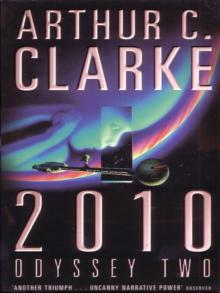 2010: Odyssey Two
2010: Odyssey Two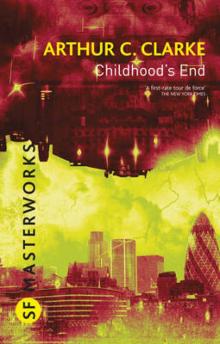 Childhood's End
Childhood's End 3001: The Final Odyssey
3001: The Final Odyssey The Fountains of Paradise
The Fountains of Paradise Rama: The Omnibus
Rama: The Omnibus The Hammer of God
The Hammer of God Beyond the Fall of Night
Beyond the Fall of Night Tales From Planet Earth
Tales From Planet Earth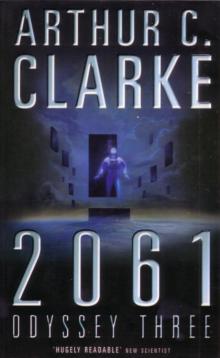 2061: Odyssey Three
2061: Odyssey Three Tales From the White Hart
Tales From the White Hart The City and the Stars/The Sands of Mars
The City and the Stars/The Sands of Mars The Star
The Star Imperial Earth
Imperial Earth The Light of Other Days
The Light of Other Days Firstborn
Firstborn The Other Side of the Sky
The Other Side of the Sky Cradle
Cradle The Wind From the Sun
The Wind From the Sun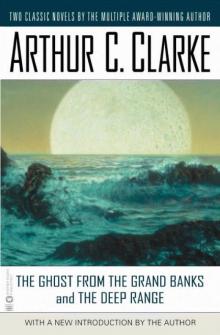 The Ghost From the Grand Banks and the Deep Range
The Ghost From the Grand Banks and the Deep Range The Deep Range
The Deep Range Expedition to Earth
Expedition to Earth A Fall of Moondust
A Fall of Moondust Dolphin Island (Arthur C. Clarke Collection)
Dolphin Island (Arthur C. Clarke Collection) Richter 10
Richter 10 The City and the Stars
The City and the Stars Tales of Ten Worlds
Tales of Ten Worlds Dolphin Island
Dolphin Island Expedition to Earth (Arthur C. Clarke Collection: Short Stories)
Expedition to Earth (Arthur C. Clarke Collection: Short Stories) Sunstorm
Sunstorm Rendezvous with Rama
Rendezvous with Rama The Collected Stories of Arthur C. Clarke
The Collected Stories of Arthur C. Clarke Trouble with the Natives
Trouble with the Natives Rama Revealed r-4
Rama Revealed r-4 The Sixth Science Fiction Megapack
The Sixth Science Fiction Megapack Firstborn to-3
Firstborn to-3 The Ghost from the Grand Banks
The Ghost from the Grand Banks Into the Comet
Into the Comet The Fires Within
The Fires Within 2061: Odyssey 3
2061: Odyssey 3 The Ninth Science Fiction Megapack
The Ninth Science Fiction Megapack The Coast of Coral
The Coast of Coral The Ghost from the Grand Banks (Arthur C. Clarke Collection)
The Ghost from the Grand Banks (Arthur C. Clarke Collection) The Space Trilogy
The Space Trilogy A Meeting With Medusa
A Meeting With Medusa 2001: A Space Odyssey (Arthur C. Clarke Collection: The Odyssey)
2001: A Space Odyssey (Arthur C. Clarke Collection: The Odyssey) Islands in the Sky (Arthur C. Clarke Collection)
Islands in the Sky (Arthur C. Clarke Collection) Rama II r-2
Rama II r-2 Glide Path (Arthur C. Clarke Collection)
Glide Path (Arthur C. Clarke Collection) The Sixth Science Fiction Megapack: 25 Classic and Modern Science Fiction Stories
The Sixth Science Fiction Megapack: 25 Classic and Modern Science Fiction Stories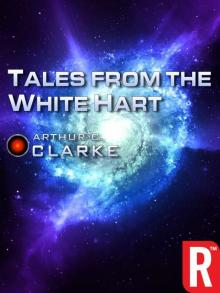 Tales from the White Hart (Arthur C. Clarke Collection: Short Stories)
Tales from the White Hart (Arthur C. Clarke Collection: Short Stories) The Reluctant Orchid
The Reluctant Orchid